Research Proposal: Qantas Airways Climate Impact Analysis Report
VerifiedAdded on 2019/11/26
|13
|2921
|160
Report
AI Summary
This report presents a research proposal analyzing the climate impact of Qantas Airways. It examines the airline's carbon emissions, sustainability initiatives, and responses to climate change through CDP disclosures. The introduction highlights the growing awareness of climate change and the role of companies in addressing it, focusing on Qantas Airways as a leading Australian airline. The report delves into practical and theoretical motivations, including Qantas's commitment to reducing emissions, using renewable resources, and its adoption of legitimacy theory. A literature review summarizes the global concern over climate change and the airline industry's environmental impact. The study proposes a conceptual model and research hypotheses to investigate Qantas's strategies, emissions reduction targets, and the overall impact of its efforts. The research questions explore the climatic impact of emissions, integration of climate strategies into business objectives, and the effectiveness of Qantas's endeavors in achieving its goals. The study is underpinned by null and alternative hypotheses, aiming to assess the influence of Qantas's actions on climate change.

Contemporary Issues in Accounting
Research Proposal
Student Name:
Your assigned research question*:
Title:
Submission Date:
1 | P a g e
Research Proposal
Student Name:
Your assigned research question*:
Title:
Submission Date:
1 | P a g e
Paraphrase This Document
Need a fresh take? Get an instant paraphrase of this document with our AI Paraphraser
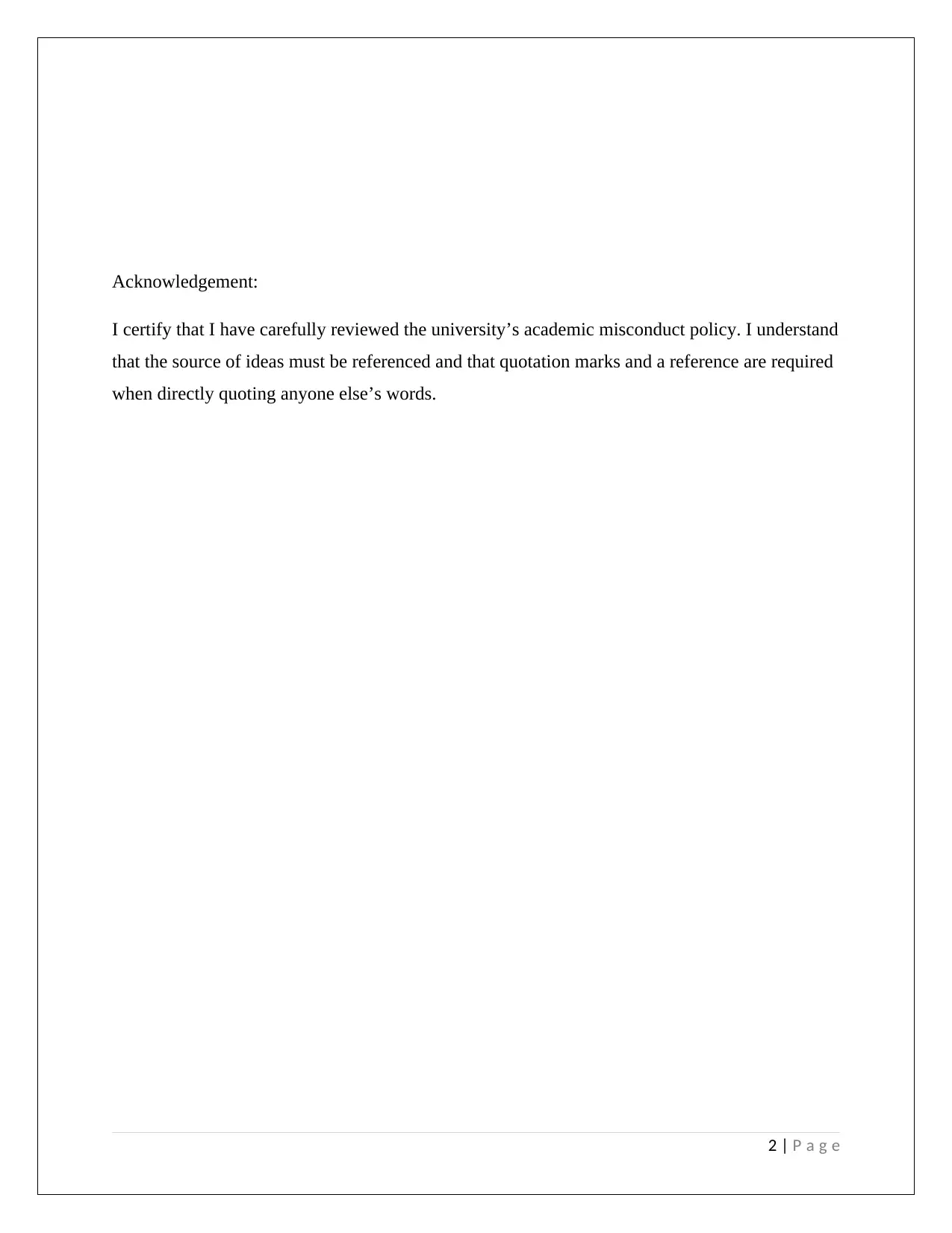
Acknowledgement:
I certify that I have carefully reviewed the university’s academic misconduct policy. I understand
that the source of ideas must be referenced and that quotation marks and a reference are required
when directly quoting anyone else’s words.
2 | P a g e
I certify that I have carefully reviewed the university’s academic misconduct policy. I understand
that the source of ideas must be referenced and that quotation marks and a reference are required
when directly quoting anyone else’s words.
2 | P a g e
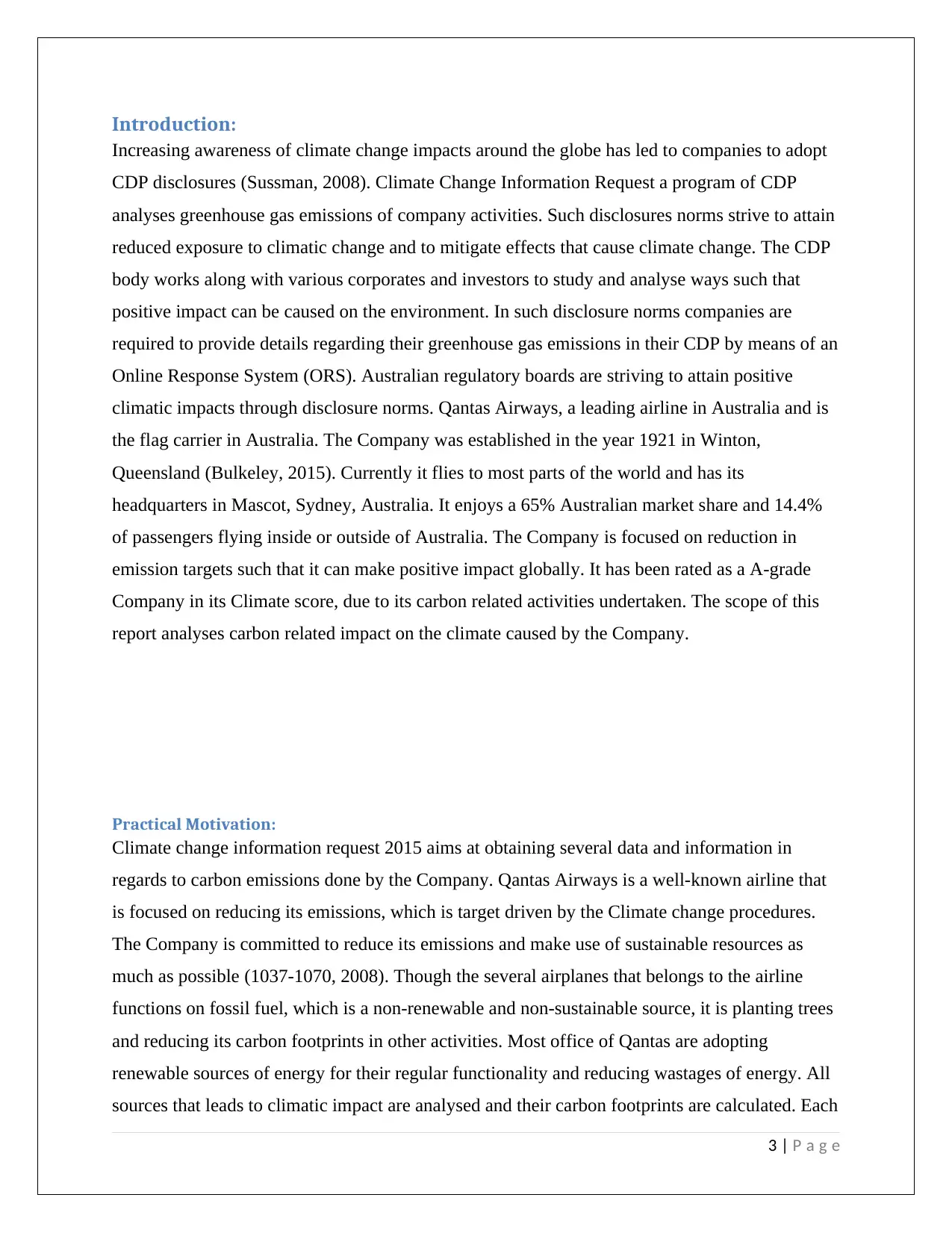
Introduction:
Increasing awareness of climate change impacts around the globe has led to companies to adopt
CDP disclosures (Sussman, 2008). Climate Change Information Request a program of CDP
analyses greenhouse gas emissions of company activities. Such disclosures norms strive to attain
reduced exposure to climatic change and to mitigate effects that cause climate change. The CDP
body works along with various corporates and investors to study and analyse ways such that
positive impact can be caused on the environment. In such disclosure norms companies are
required to provide details regarding their greenhouse gas emissions in their CDP by means of an
Online Response System (ORS). Australian regulatory boards are striving to attain positive
climatic impacts through disclosure norms. Qantas Airways, a leading airline in Australia and is
the flag carrier in Australia. The Company was established in the year 1921 in Winton,
Queensland (Bulkeley, 2015). Currently it flies to most parts of the world and has its
headquarters in Mascot, Sydney, Australia. It enjoys a 65% Australian market share and 14.4%
of passengers flying inside or outside of Australia. The Company is focused on reduction in
emission targets such that it can make positive impact globally. It has been rated as a A-grade
Company in its Climate score, due to its carbon related activities undertaken. The scope of this
report analyses carbon related impact on the climate caused by the Company.
Practical Motivation:
Climate change information request 2015 aims at obtaining several data and information in
regards to carbon emissions done by the Company. Qantas Airways is a well-known airline that
is focused on reducing its emissions, which is target driven by the Climate change procedures.
The Company is committed to reduce its emissions and make use of sustainable resources as
much as possible (1037-1070, 2008). Though the several airplanes that belongs to the airline
functions on fossil fuel, which is a non-renewable and non-sustainable source, it is planting trees
and reducing its carbon footprints in other activities. Most office of Qantas are adopting
renewable sources of energy for their regular functionality and reducing wastages of energy. All
sources that leads to climatic impact are analysed and their carbon footprints are calculated. Each
3 | P a g e
Increasing awareness of climate change impacts around the globe has led to companies to adopt
CDP disclosures (Sussman, 2008). Climate Change Information Request a program of CDP
analyses greenhouse gas emissions of company activities. Such disclosures norms strive to attain
reduced exposure to climatic change and to mitigate effects that cause climate change. The CDP
body works along with various corporates and investors to study and analyse ways such that
positive impact can be caused on the environment. In such disclosure norms companies are
required to provide details regarding their greenhouse gas emissions in their CDP by means of an
Online Response System (ORS). Australian regulatory boards are striving to attain positive
climatic impacts through disclosure norms. Qantas Airways, a leading airline in Australia and is
the flag carrier in Australia. The Company was established in the year 1921 in Winton,
Queensland (Bulkeley, 2015). Currently it flies to most parts of the world and has its
headquarters in Mascot, Sydney, Australia. It enjoys a 65% Australian market share and 14.4%
of passengers flying inside or outside of Australia. The Company is focused on reduction in
emission targets such that it can make positive impact globally. It has been rated as a A-grade
Company in its Climate score, due to its carbon related activities undertaken. The scope of this
report analyses carbon related impact on the climate caused by the Company.
Practical Motivation:
Climate change information request 2015 aims at obtaining several data and information in
regards to carbon emissions done by the Company. Qantas Airways is a well-known airline that
is focused on reducing its emissions, which is target driven by the Climate change procedures.
The Company is committed to reduce its emissions and make use of sustainable resources as
much as possible (1037-1070, 2008). Though the several airplanes that belongs to the airline
functions on fossil fuel, which is a non-renewable and non-sustainable source, it is planting trees
and reducing its carbon footprints in other activities. Most office of Qantas are adopting
renewable sources of energy for their regular functionality and reducing wastages of energy. All
sources that leads to climatic impact are analysed and their carbon footprints are calculated. Each
3 | P a g e
⊘ This is a preview!⊘
Do you want full access?
Subscribe today to unlock all pages.

Trusted by 1+ million students worldwide

of such items are taken and transformed in an endeavor to reduce impact. The Company is
focused on innovation and sustaining renewable mechanisms for every purposes, also devising
means by which fossil fuel can best be replaced. Except for where necessary, the Company is not
making use of fossil fuel adapting to efficient energy usages (Karim, 2008). At various offices it
is making use of solar panels and wind energy sources to reduce its impact on the climate. The
Company has adopted all possible means to store and publish data that are in accordance to its
Climate impact. Its disclosure agreement provides detailed data and procedures regarding each
and every heads that are provided by the CDP. The high scoring potentiality of the Company is
reflected by the valuable perspective it attaches to the activities that is being performed by the
Company for responding to climate change. Through operational excellence and energy efficient
usage, it has been able to make considerable impact on creating an innovative measure.
Theoretical Motivation:
The Paris Agreement has been ratified at a very fact pace determining heavy reliance on
developing Sustainable Developmental Goals (SDGs) on corporates. The new agreement makes
it clear that for climate change to be impacted, corporates needs to adapt to norms and
procedures that prevents further degradation of the environment. Business strategies needs to
revolutionize their businesses based on low-carbon that can limit rise in temperatures (Cotter,
2012). Preventing global warming has become a heavy task, with generation of reliance on
everyone to contribute towards the cause in an unprecedented manner. For the scope of the
current analysis of Qantas Airlines, legitimacy theory has been adopted. Legitimacy theory
considers generalized perception in regards to beliefs and actions of an entity on basis of socially
constructed norms. Legitimacy theory applied on this study will consider that climate
degradation has been initiated and, Qantas is trying to make a positive impact to restore such
degradation. There is a tremendous amounts of stress that is caused on the climate due to carbon
emissions from several activity that can be reduced by socially accepted norm of legitimacy
theory (Mills, 2009). The theory allows development and consideration of several facts and
figures that will help development of the study and to reach its goals and objectives.
4 | P a g e
focused on innovation and sustaining renewable mechanisms for every purposes, also devising
means by which fossil fuel can best be replaced. Except for where necessary, the Company is not
making use of fossil fuel adapting to efficient energy usages (Karim, 2008). At various offices it
is making use of solar panels and wind energy sources to reduce its impact on the climate. The
Company has adopted all possible means to store and publish data that are in accordance to its
Climate impact. Its disclosure agreement provides detailed data and procedures regarding each
and every heads that are provided by the CDP. The high scoring potentiality of the Company is
reflected by the valuable perspective it attaches to the activities that is being performed by the
Company for responding to climate change. Through operational excellence and energy efficient
usage, it has been able to make considerable impact on creating an innovative measure.
Theoretical Motivation:
The Paris Agreement has been ratified at a very fact pace determining heavy reliance on
developing Sustainable Developmental Goals (SDGs) on corporates. The new agreement makes
it clear that for climate change to be impacted, corporates needs to adapt to norms and
procedures that prevents further degradation of the environment. Business strategies needs to
revolutionize their businesses based on low-carbon that can limit rise in temperatures (Cotter,
2012). Preventing global warming has become a heavy task, with generation of reliance on
everyone to contribute towards the cause in an unprecedented manner. For the scope of the
current analysis of Qantas Airlines, legitimacy theory has been adopted. Legitimacy theory
considers generalized perception in regards to beliefs and actions of an entity on basis of socially
constructed norms. Legitimacy theory applied on this study will consider that climate
degradation has been initiated and, Qantas is trying to make a positive impact to restore such
degradation. There is a tremendous amounts of stress that is caused on the climate due to carbon
emissions from several activity that can be reduced by socially accepted norm of legitimacy
theory (Mills, 2009). The theory allows development and consideration of several facts and
figures that will help development of the study and to reach its goals and objectives.
4 | P a g e
Paraphrase This Document
Need a fresh take? Get an instant paraphrase of this document with our AI Paraphraser
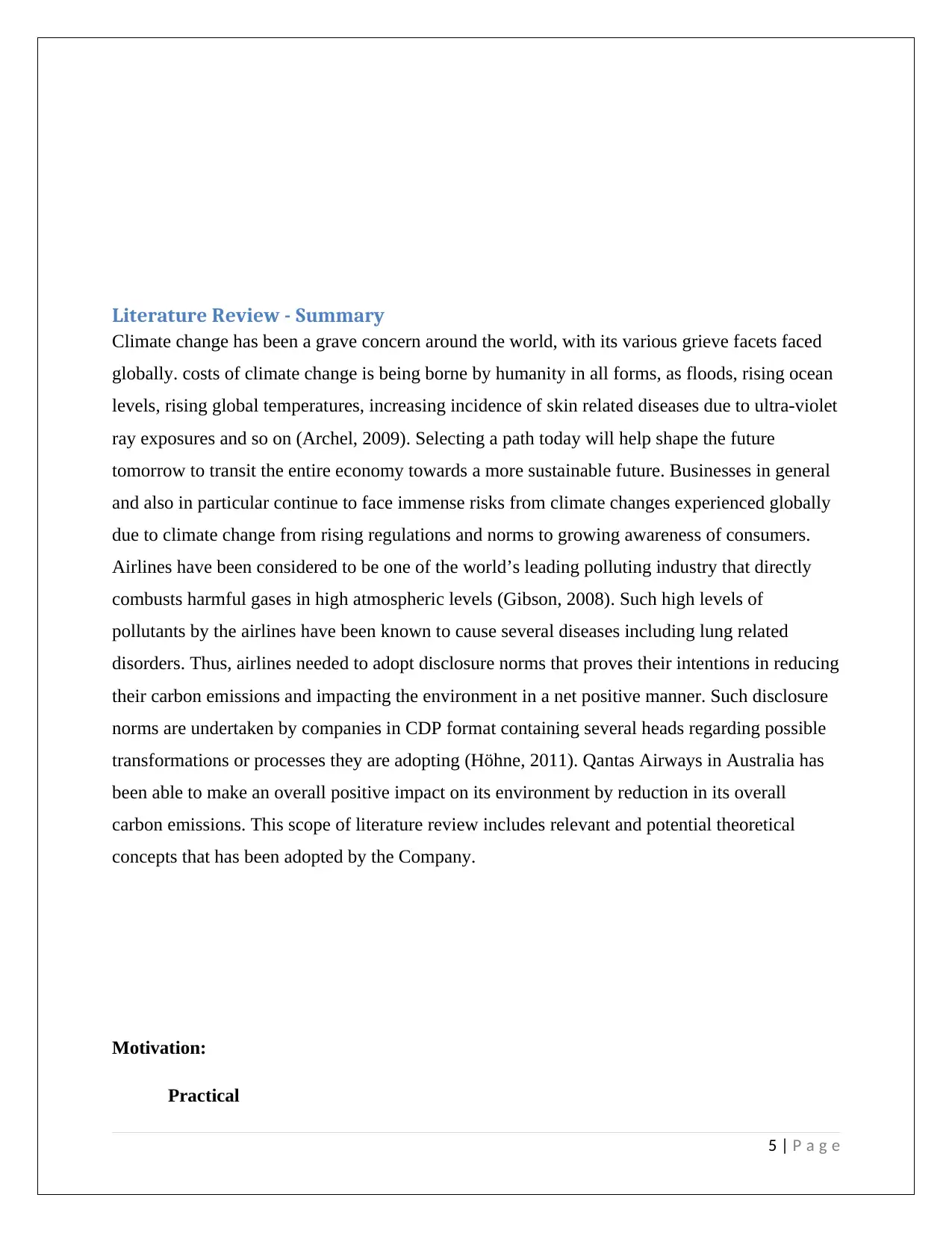
Literature Review - Summary
Climate change has been a grave concern around the world, with its various grieve facets faced
globally. costs of climate change is being borne by humanity in all forms, as floods, rising ocean
levels, rising global temperatures, increasing incidence of skin related diseases due to ultra-violet
ray exposures and so on (Archel, 2009). Selecting a path today will help shape the future
tomorrow to transit the entire economy towards a more sustainable future. Businesses in general
and also in particular continue to face immense risks from climate changes experienced globally
due to climate change from rising regulations and norms to growing awareness of consumers.
Airlines have been considered to be one of the world’s leading polluting industry that directly
combusts harmful gases in high atmospheric levels (Gibson, 2008). Such high levels of
pollutants by the airlines have been known to cause several diseases including lung related
disorders. Thus, airlines needed to adopt disclosure norms that proves their intentions in reducing
their carbon emissions and impacting the environment in a net positive manner. Such disclosure
norms are undertaken by companies in CDP format containing several heads regarding possible
transformations or processes they are adopting (Höhne, 2011). Qantas Airways in Australia has
been able to make an overall positive impact on its environment by reduction in its overall
carbon emissions. This scope of literature review includes relevant and potential theoretical
concepts that has been adopted by the Company.
Motivation:
Practical
5 | P a g e
Climate change has been a grave concern around the world, with its various grieve facets faced
globally. costs of climate change is being borne by humanity in all forms, as floods, rising ocean
levels, rising global temperatures, increasing incidence of skin related diseases due to ultra-violet
ray exposures and so on (Archel, 2009). Selecting a path today will help shape the future
tomorrow to transit the entire economy towards a more sustainable future. Businesses in general
and also in particular continue to face immense risks from climate changes experienced globally
due to climate change from rising regulations and norms to growing awareness of consumers.
Airlines have been considered to be one of the world’s leading polluting industry that directly
combusts harmful gases in high atmospheric levels (Gibson, 2008). Such high levels of
pollutants by the airlines have been known to cause several diseases including lung related
disorders. Thus, airlines needed to adopt disclosure norms that proves their intentions in reducing
their carbon emissions and impacting the environment in a net positive manner. Such disclosure
norms are undertaken by companies in CDP format containing several heads regarding possible
transformations or processes they are adopting (Höhne, 2011). Qantas Airways in Australia has
been able to make an overall positive impact on its environment by reduction in its overall
carbon emissions. This scope of literature review includes relevant and potential theoretical
concepts that has been adopted by the Company.
Motivation:
Practical
5 | P a g e
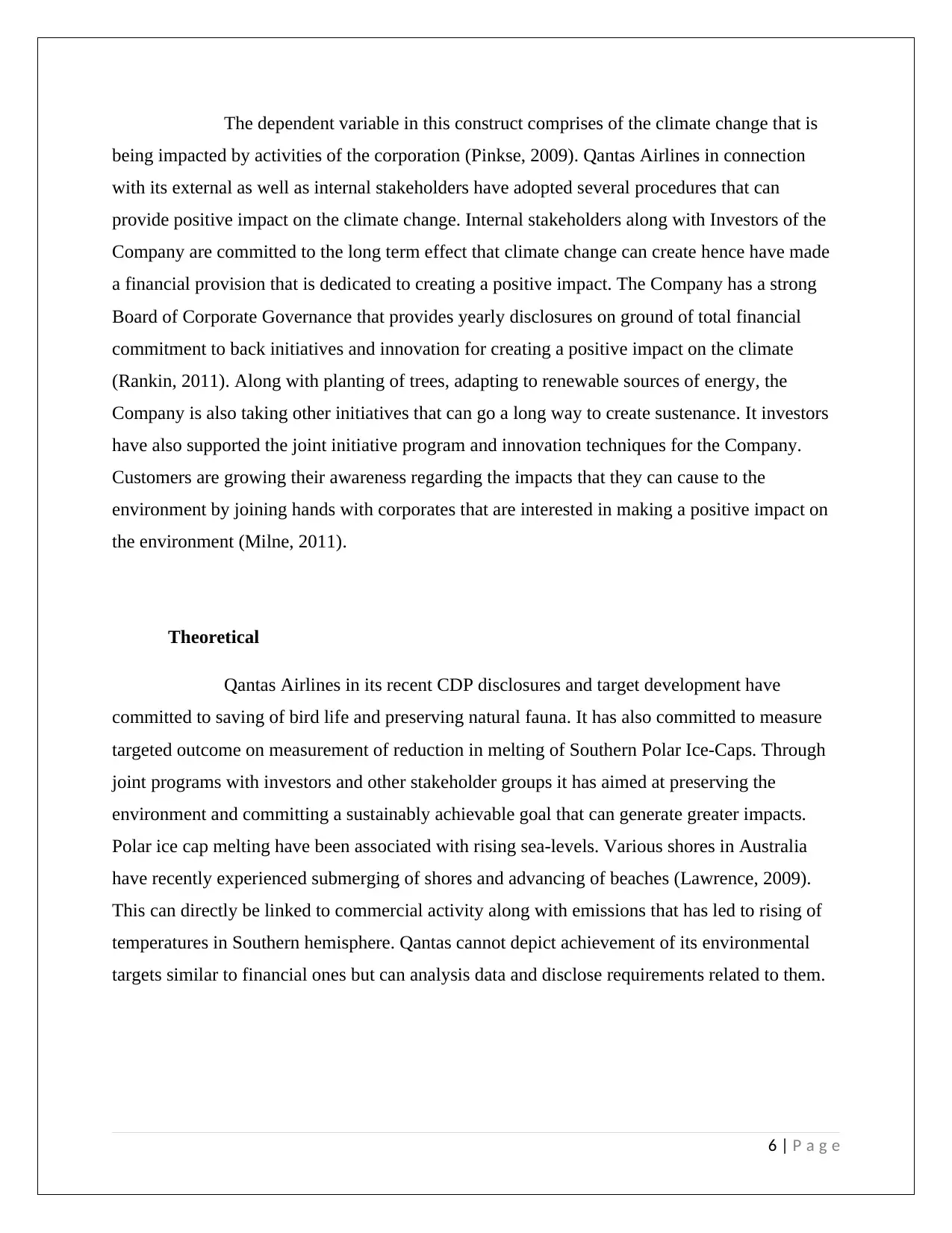
The dependent variable in this construct comprises of the climate change that is
being impacted by activities of the corporation (Pinkse, 2009). Qantas Airlines in connection
with its external as well as internal stakeholders have adopted several procedures that can
provide positive impact on the climate change. Internal stakeholders along with Investors of the
Company are committed to the long term effect that climate change can create hence have made
a financial provision that is dedicated to creating a positive impact. The Company has a strong
Board of Corporate Governance that provides yearly disclosures on ground of total financial
commitment to back initiatives and innovation for creating a positive impact on the climate
(Rankin, 2011). Along with planting of trees, adapting to renewable sources of energy, the
Company is also taking other initiatives that can go a long way to create sustenance. It investors
have also supported the joint initiative program and innovation techniques for the Company.
Customers are growing their awareness regarding the impacts that they can cause to the
environment by joining hands with corporates that are interested in making a positive impact on
the environment (Milne, 2011).
Theoretical
Qantas Airlines in its recent CDP disclosures and target development have
committed to saving of bird life and preserving natural fauna. It has also committed to measure
targeted outcome on measurement of reduction in melting of Southern Polar Ice-Caps. Through
joint programs with investors and other stakeholder groups it has aimed at preserving the
environment and committing a sustainably achievable goal that can generate greater impacts.
Polar ice cap melting have been associated with rising sea-levels. Various shores in Australia
have recently experienced submerging of shores and advancing of beaches (Lawrence, 2009).
This can directly be linked to commercial activity along with emissions that has led to rising of
temperatures in Southern hemisphere. Qantas cannot depict achievement of its environmental
targets similar to financial ones but can analysis data and disclose requirements related to them.
6 | P a g e
being impacted by activities of the corporation (Pinkse, 2009). Qantas Airlines in connection
with its external as well as internal stakeholders have adopted several procedures that can
provide positive impact on the climate change. Internal stakeholders along with Investors of the
Company are committed to the long term effect that climate change can create hence have made
a financial provision that is dedicated to creating a positive impact. The Company has a strong
Board of Corporate Governance that provides yearly disclosures on ground of total financial
commitment to back initiatives and innovation for creating a positive impact on the climate
(Rankin, 2011). Along with planting of trees, adapting to renewable sources of energy, the
Company is also taking other initiatives that can go a long way to create sustenance. It investors
have also supported the joint initiative program and innovation techniques for the Company.
Customers are growing their awareness regarding the impacts that they can cause to the
environment by joining hands with corporates that are interested in making a positive impact on
the environment (Milne, 2011).
Theoretical
Qantas Airlines in its recent CDP disclosures and target development have
committed to saving of bird life and preserving natural fauna. It has also committed to measure
targeted outcome on measurement of reduction in melting of Southern Polar Ice-Caps. Through
joint programs with investors and other stakeholder groups it has aimed at preserving the
environment and committing a sustainably achievable goal that can generate greater impacts.
Polar ice cap melting have been associated with rising sea-levels. Various shores in Australia
have recently experienced submerging of shores and advancing of beaches (Lawrence, 2009).
This can directly be linked to commercial activity along with emissions that has led to rising of
temperatures in Southern hemisphere. Qantas cannot depict achievement of its environmental
targets similar to financial ones but can analysis data and disclose requirements related to them.
6 | P a g e
⊘ This is a preview!⊘
Do you want full access?
Subscribe today to unlock all pages.

Trusted by 1+ million students worldwide
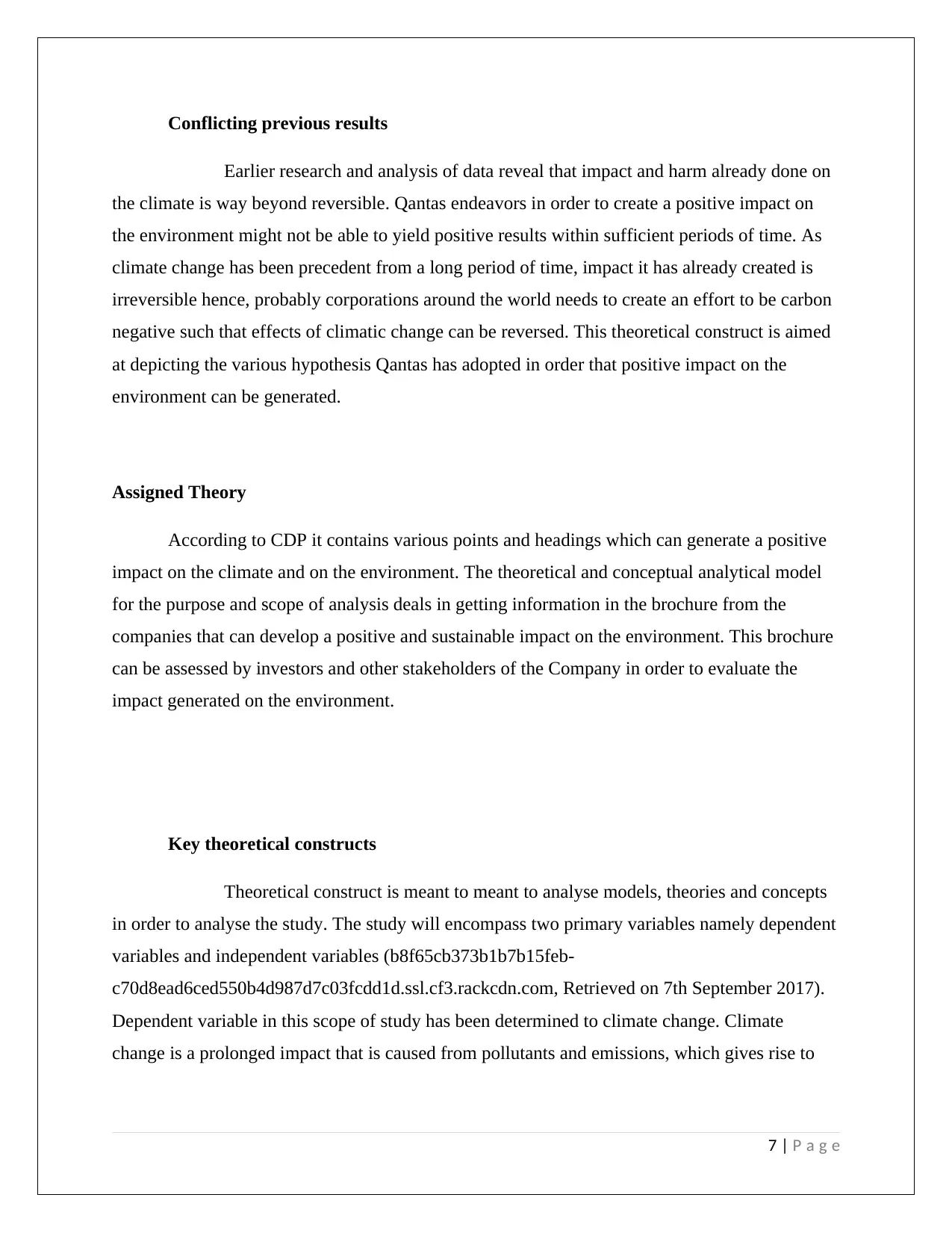
Conflicting previous results
Earlier research and analysis of data reveal that impact and harm already done on
the climate is way beyond reversible. Qantas endeavors in order to create a positive impact on
the environment might not be able to yield positive results within sufficient periods of time. As
climate change has been precedent from a long period of time, impact it has already created is
irreversible hence, probably corporations around the world needs to create an effort to be carbon
negative such that effects of climatic change can be reversed. This theoretical construct is aimed
at depicting the various hypothesis Qantas has adopted in order that positive impact on the
environment can be generated.
Assigned Theory
According to CDP it contains various points and headings which can generate a positive
impact on the climate and on the environment. The theoretical and conceptual analytical model
for the purpose and scope of analysis deals in getting information in the brochure from the
companies that can develop a positive and sustainable impact on the environment. This brochure
can be assessed by investors and other stakeholders of the Company in order to evaluate the
impact generated on the environment.
Key theoretical constructs
Theoretical construct is meant to meant to analyse models, theories and concepts
in order to analyse the study. The study will encompass two primary variables namely dependent
variables and independent variables (b8f65cb373b1b7b15feb-
c70d8ead6ced550b4d987d7c03fcdd1d.ssl.cf3.rackcdn.com, Retrieved on 7th September 2017).
Dependent variable in this scope of study has been determined to climate change. Climate
change is a prolonged impact that is caused from pollutants and emissions, which gives rise to
7 | P a g e
Earlier research and analysis of data reveal that impact and harm already done on
the climate is way beyond reversible. Qantas endeavors in order to create a positive impact on
the environment might not be able to yield positive results within sufficient periods of time. As
climate change has been precedent from a long period of time, impact it has already created is
irreversible hence, probably corporations around the world needs to create an effort to be carbon
negative such that effects of climatic change can be reversed. This theoretical construct is aimed
at depicting the various hypothesis Qantas has adopted in order that positive impact on the
environment can be generated.
Assigned Theory
According to CDP it contains various points and headings which can generate a positive
impact on the climate and on the environment. The theoretical and conceptual analytical model
for the purpose and scope of analysis deals in getting information in the brochure from the
companies that can develop a positive and sustainable impact on the environment. This brochure
can be assessed by investors and other stakeholders of the Company in order to evaluate the
impact generated on the environment.
Key theoretical constructs
Theoretical construct is meant to meant to analyse models, theories and concepts
in order to analyse the study. The study will encompass two primary variables namely dependent
variables and independent variables (b8f65cb373b1b7b15feb-
c70d8ead6ced550b4d987d7c03fcdd1d.ssl.cf3.rackcdn.com, Retrieved on 7th September 2017).
Dependent variable in this scope of study has been determined to climate change. Climate
change is a prolonged impact that is caused from pollutants and emissions, which gives rise to
7 | P a g e
Paraphrase This Document
Need a fresh take? Get an instant paraphrase of this document with our AI Paraphraser
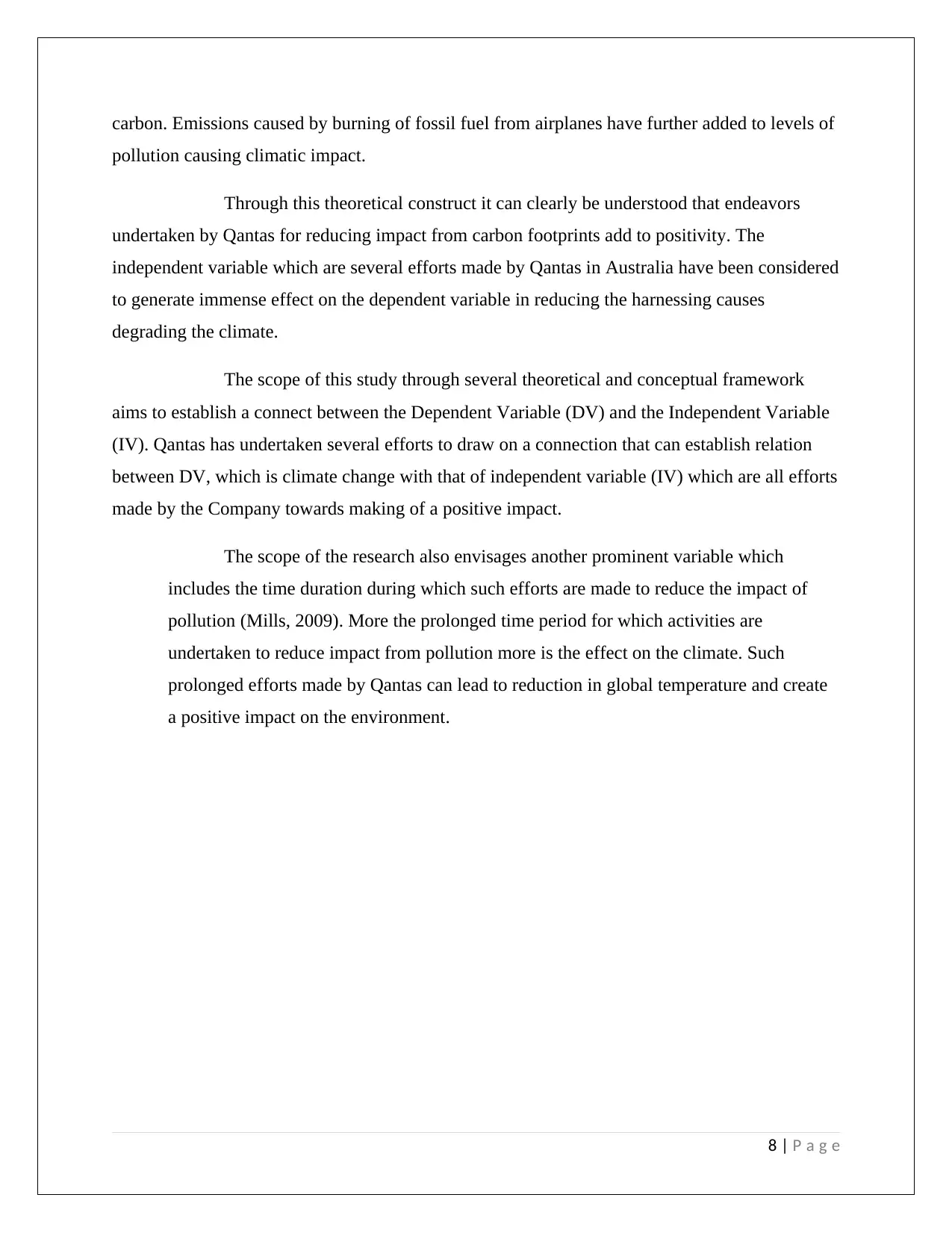
carbon. Emissions caused by burning of fossil fuel from airplanes have further added to levels of
pollution causing climatic impact.
Through this theoretical construct it can clearly be understood that endeavors
undertaken by Qantas for reducing impact from carbon footprints add to positivity. The
independent variable which are several efforts made by Qantas in Australia have been considered
to generate immense effect on the dependent variable in reducing the harnessing causes
degrading the climate.
The scope of this study through several theoretical and conceptual framework
aims to establish a connect between the Dependent Variable (DV) and the Independent Variable
(IV). Qantas has undertaken several efforts to draw on a connection that can establish relation
between DV, which is climate change with that of independent variable (IV) which are all efforts
made by the Company towards making of a positive impact.
The scope of the research also envisages another prominent variable which
includes the time duration during which such efforts are made to reduce the impact of
pollution (Mills, 2009). More the prolonged time period for which activities are
undertaken to reduce impact from pollution more is the effect on the climate. Such
prolonged efforts made by Qantas can lead to reduction in global temperature and create
a positive impact on the environment.
8 | P a g e
pollution causing climatic impact.
Through this theoretical construct it can clearly be understood that endeavors
undertaken by Qantas for reducing impact from carbon footprints add to positivity. The
independent variable which are several efforts made by Qantas in Australia have been considered
to generate immense effect on the dependent variable in reducing the harnessing causes
degrading the climate.
The scope of this study through several theoretical and conceptual framework
aims to establish a connect between the Dependent Variable (DV) and the Independent Variable
(IV). Qantas has undertaken several efforts to draw on a connection that can establish relation
between DV, which is climate change with that of independent variable (IV) which are all efforts
made by the Company towards making of a positive impact.
The scope of the research also envisages another prominent variable which
includes the time duration during which such efforts are made to reduce the impact of
pollution (Mills, 2009). More the prolonged time period for which activities are
undertaken to reduce impact from pollution more is the effect on the climate. Such
prolonged efforts made by Qantas can lead to reduction in global temperature and create
a positive impact on the environment.
8 | P a g e
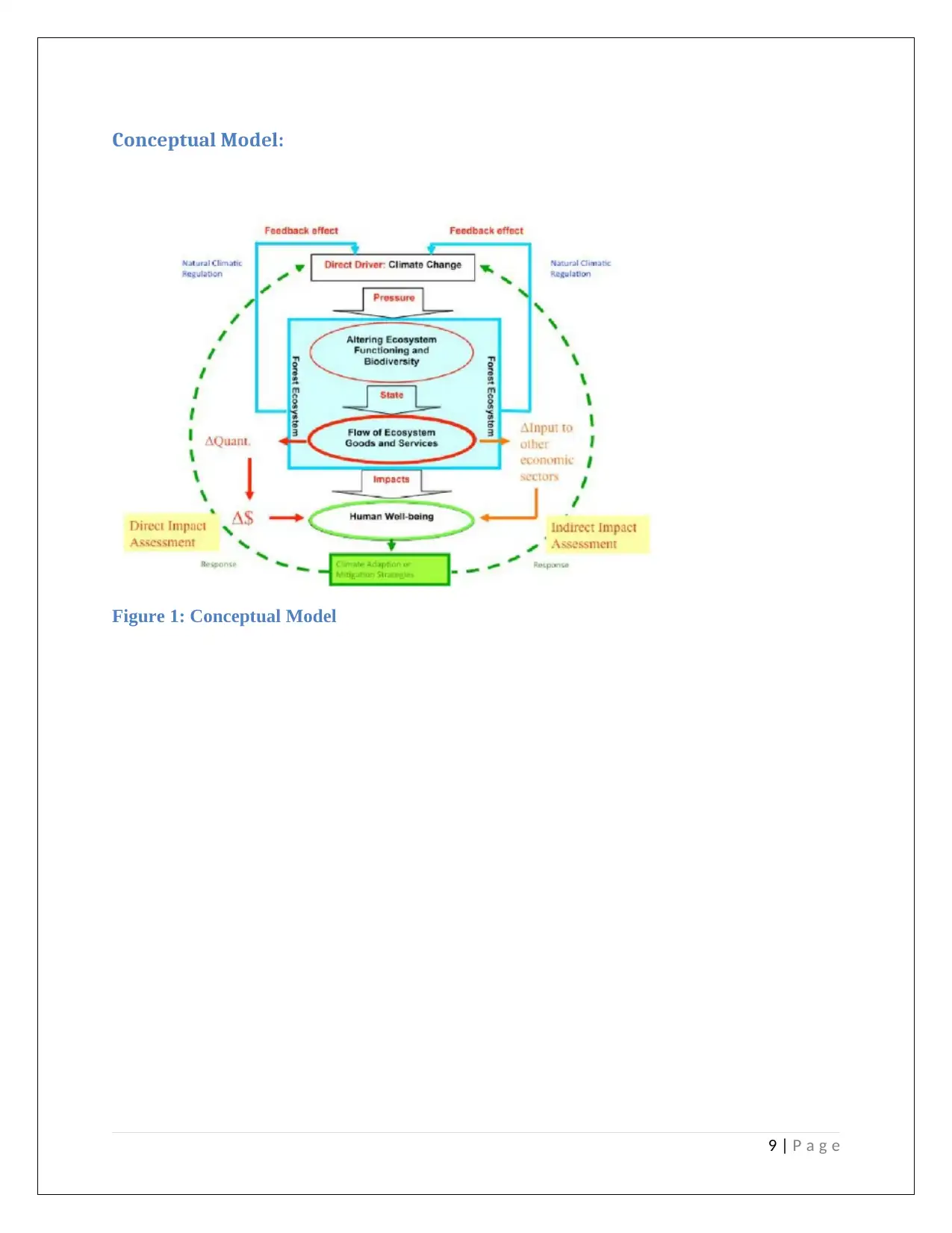
Conceptual Model:
Figure 1: Conceptual Model
9 | P a g e
Figure 1: Conceptual Model
9 | P a g e
⊘ This is a preview!⊘
Do you want full access?
Subscribe today to unlock all pages.

Trusted by 1+ million students worldwide

Hypotheses
The research hypothesis for the study is aimed at researching the following questions.
Research Question 1: What is climatic impact from various emissions by Qantas Airways?
Research Question 2: What ways has Qantas Airways strategized climatic impacts into business
objectives?
Research Question 3: How are the endeavors made by Qantas Airways focused?
Research Question 4: What is the targeted emissions reduction in the current year against past
years?
For the purpose of this study, there will be two hypothesis that will be assumed in the scope of
discussion. Null Hypothesis (H0) and the alternate Hypothesis (H1), which will be governed by
the variables. In the Null Hypothesis the basis of assumption lies that climatic change will not be
impacted through any endeavors undertaken by Qantas. Whereas in the Alternate Hypothesis, it
has been assumed that DV which is the climate change will be a function of the IV which are
several activities undertaken by Qantas. The study will aim to establish truth of alternate
hypothesis and reject null hypothesis in totality.
Proxy Measures for Theoretical Constructs
Theoretical
Construct
Proxy measure Dependent (DV),
Independent (IV),
or Control Variable
(CV)
Source
Impact on
Southern Ice-
Caps
Rate at which
ice-caps are
melting
DV-Climate Change
IV-Activities
undertaken by
Qantas Airways
Qantas Airways CDP data
Rising water
levels in
Australian shores
Flooding and
rising sea-levels
along sea-
DV-Climate Change
IV-Activities
undertaken by
Scientific data measures and
collection
10 | P a g e
The research hypothesis for the study is aimed at researching the following questions.
Research Question 1: What is climatic impact from various emissions by Qantas Airways?
Research Question 2: What ways has Qantas Airways strategized climatic impacts into business
objectives?
Research Question 3: How are the endeavors made by Qantas Airways focused?
Research Question 4: What is the targeted emissions reduction in the current year against past
years?
For the purpose of this study, there will be two hypothesis that will be assumed in the scope of
discussion. Null Hypothesis (H0) and the alternate Hypothesis (H1), which will be governed by
the variables. In the Null Hypothesis the basis of assumption lies that climatic change will not be
impacted through any endeavors undertaken by Qantas. Whereas in the Alternate Hypothesis, it
has been assumed that DV which is the climate change will be a function of the IV which are
several activities undertaken by Qantas. The study will aim to establish truth of alternate
hypothesis and reject null hypothesis in totality.
Proxy Measures for Theoretical Constructs
Theoretical
Construct
Proxy measure Dependent (DV),
Independent (IV),
or Control Variable
(CV)
Source
Impact on
Southern Ice-
Caps
Rate at which
ice-caps are
melting
DV-Climate Change
IV-Activities
undertaken by
Qantas Airways
Qantas Airways CDP data
Rising water
levels in
Australian shores
Flooding and
rising sea-levels
along sea-
DV-Climate Change
IV-Activities
undertaken by
Scientific data measures and
collection
10 | P a g e
Paraphrase This Document
Need a fresh take? Get an instant paraphrase of this document with our AI Paraphraser
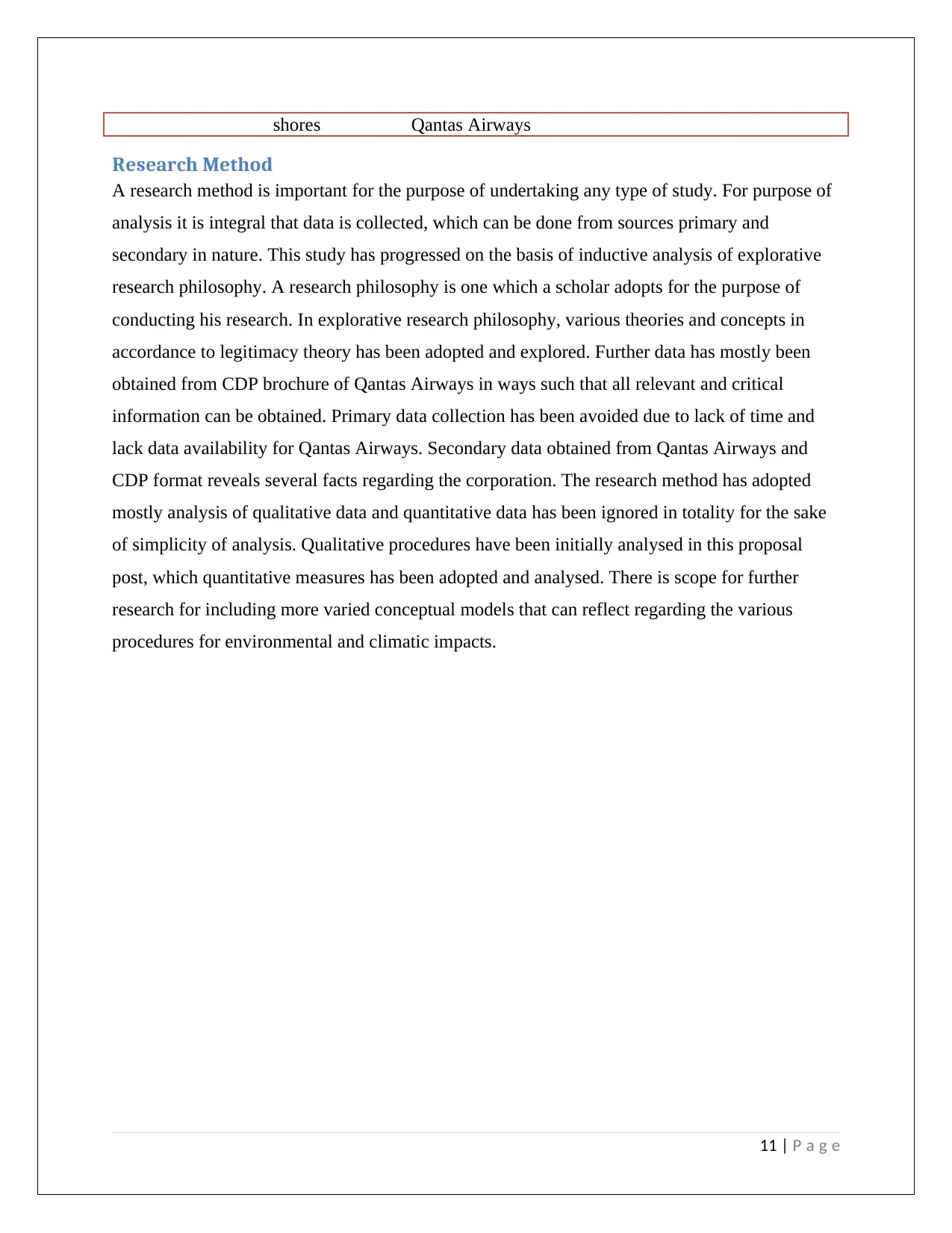
shores Qantas Airways
Research Method
A research method is important for the purpose of undertaking any type of study. For purpose of
analysis it is integral that data is collected, which can be done from sources primary and
secondary in nature. This study has progressed on the basis of inductive analysis of explorative
research philosophy. A research philosophy is one which a scholar adopts for the purpose of
conducting his research. In explorative research philosophy, various theories and concepts in
accordance to legitimacy theory has been adopted and explored. Further data has mostly been
obtained from CDP brochure of Qantas Airways in ways such that all relevant and critical
information can be obtained. Primary data collection has been avoided due to lack of time and
lack data availability for Qantas Airways. Secondary data obtained from Qantas Airways and
CDP format reveals several facts regarding the corporation. The research method has adopted
mostly analysis of qualitative data and quantitative data has been ignored in totality for the sake
of simplicity of analysis. Qualitative procedures have been initially analysed in this proposal
post, which quantitative measures has been adopted and analysed. There is scope for further
research for including more varied conceptual models that can reflect regarding the various
procedures for environmental and climatic impacts.
11 | P a g e
Research Method
A research method is important for the purpose of undertaking any type of study. For purpose of
analysis it is integral that data is collected, which can be done from sources primary and
secondary in nature. This study has progressed on the basis of inductive analysis of explorative
research philosophy. A research philosophy is one which a scholar adopts for the purpose of
conducting his research. In explorative research philosophy, various theories and concepts in
accordance to legitimacy theory has been adopted and explored. Further data has mostly been
obtained from CDP brochure of Qantas Airways in ways such that all relevant and critical
information can be obtained. Primary data collection has been avoided due to lack of time and
lack data availability for Qantas Airways. Secondary data obtained from Qantas Airways and
CDP format reveals several facts regarding the corporation. The research method has adopted
mostly analysis of qualitative data and quantitative data has been ignored in totality for the sake
of simplicity of analysis. Qualitative procedures have been initially analysed in this proposal
post, which quantitative measures has been adopted and analysed. There is scope for further
research for including more varied conceptual models that can reflect regarding the various
procedures for environmental and climatic impacts.
11 | P a g e

Reference Lists
1037-1070. (2008). The strategic significance of environmental sustainability by Australian-
listed property trusts. Journal of Property Investment & Finance, 522-540.
Archel, P. H. (2009). Social disclosure, legitimacy theory and the role of the state. Accounting,
auditing & accountability journal, 1284-1307.
b8f65cb373b1b7b15feb-c70d8ead6ced550b4d987d7c03fcdd1d.ssl.cf3.rackcdn.com. (Retrieved
on 7th September 2017). Australian Climate Leadership Report.
https://b8f65cb373b1b7b15feb-
c70d8ead6ced550b4d987d7c03fcdd1d.ssl.cf3.rackcdn.com/cms/reports/documents/
000/001/351/original/Australian-Climate-Leadership-Report-2016.pdf?1480342252.
Bulkeley, H. &. (2015). Governing climate change. Routledge.
Cotter, J. &. (2012). Institutional investor influence on global climate change disclosure
practices. Australian journal of management, 169-187.
Gibson, J. L. (2008). Challenges to the impartiality of state supreme courts: Legitimacy theory
and “new-style” judicial campaigns. American Political Science Review, 59-75.
Höhne, N. B. (2011). Contributions of individual countries’ emissions to climate change and
their uncertainty. Climatic change, 359-391.
Karim, M. F. (2008). Impacts of climate change and sea-level rise on cyclonic storm surge floods
in Bangladesh. Global Environmental Change, 490-500.
Lawrence, P. (2009). Australian climate policy and the Asia Pacific partnership on clean
development and climate (APP). From Howard to Rudd: continuity or change?
International Environmental Agreements: Politics, Law and Economics, 281-299.
Mills, E. (2009). A global review of insurance industry responses to climate change. The Geneva
Papers on Risk and Insurance-Issues and Practice, 323-359.
12 | P a g e
1037-1070. (2008). The strategic significance of environmental sustainability by Australian-
listed property trusts. Journal of Property Investment & Finance, 522-540.
Archel, P. H. (2009). Social disclosure, legitimacy theory and the role of the state. Accounting,
auditing & accountability journal, 1284-1307.
b8f65cb373b1b7b15feb-c70d8ead6ced550b4d987d7c03fcdd1d.ssl.cf3.rackcdn.com. (Retrieved
on 7th September 2017). Australian Climate Leadership Report.
https://b8f65cb373b1b7b15feb-
c70d8ead6ced550b4d987d7c03fcdd1d.ssl.cf3.rackcdn.com/cms/reports/documents/
000/001/351/original/Australian-Climate-Leadership-Report-2016.pdf?1480342252.
Bulkeley, H. &. (2015). Governing climate change. Routledge.
Cotter, J. &. (2012). Institutional investor influence on global climate change disclosure
practices. Australian journal of management, 169-187.
Gibson, J. L. (2008). Challenges to the impartiality of state supreme courts: Legitimacy theory
and “new-style” judicial campaigns. American Political Science Review, 59-75.
Höhne, N. B. (2011). Contributions of individual countries’ emissions to climate change and
their uncertainty. Climatic change, 359-391.
Karim, M. F. (2008). Impacts of climate change and sea-level rise on cyclonic storm surge floods
in Bangladesh. Global Environmental Change, 490-500.
Lawrence, P. (2009). Australian climate policy and the Asia Pacific partnership on clean
development and climate (APP). From Howard to Rudd: continuity or change?
International Environmental Agreements: Politics, Law and Economics, 281-299.
Mills, E. (2009). A global review of insurance industry responses to climate change. The Geneva
Papers on Risk and Insurance-Issues and Practice, 323-359.
12 | P a g e
⊘ This is a preview!⊘
Do you want full access?
Subscribe today to unlock all pages.

Trusted by 1+ million students worldwide
1 out of 13
Related Documents
Your All-in-One AI-Powered Toolkit for Academic Success.
+13062052269
info@desklib.com
Available 24*7 on WhatsApp / Email
![[object Object]](/_next/static/media/star-bottom.7253800d.svg)
Unlock your academic potential
Copyright © 2020–2025 A2Z Services. All Rights Reserved. Developed and managed by ZUCOL.





